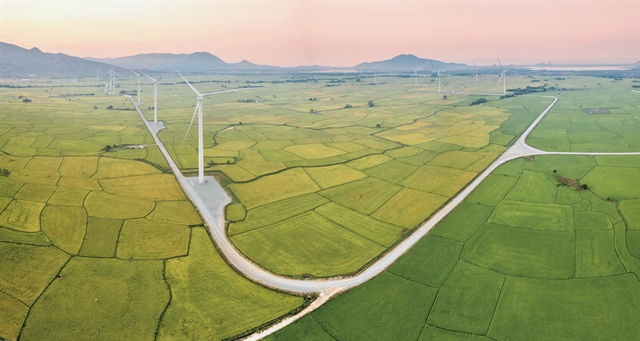Viet Nam sees big opportunities in wind energy
Viet Nam’s commitment to increasing its energy capacity using renewable sources and favourable macroeconomic conditions may create valuable opportunities for wind investors and developers.
 |
| Viet Nam has made significant progress on expanding its capacity to generate renewable energy. — Photo courtesy of the firm |
The information was released in the latest report by McKinsey & Company titled “Capturing the wind: Renewable-energy opportunities in Viet Nam”, to study the great potential of wind as an alternative renewable energy source, and explain why this may be the right time for wind energy investors and developers to explore and exploit opportunities in Viet Nam.
Viet Nam has made significant progress on expanding its capacity to generate renewable energy. The vast majority of that expansion to date has come from photovoltaic (PV) solar installations, in large part driven by private investment. Still, coal retains a dominant share of the energy mix today, accounting for more than 50 per cent of the capacity added since 2018, which has contributed to persistent poor air quality. According to a 2019 report from the Ministry of Natural Resources and Environment, for example, pollution metrics in Hà Nội reached historical highs before the pandemic despite a variety of efforts.
Several factors in the Vietnamese market suggest that wind investors and developers can find significant opportunities for growth. In addition to the sizable natural potential for wind projects, the Government is indicating its strong support for wind development. For example, the extension of feed-in tariffs (FiTs) for wind-power projects from 2021 to the end of 2023 underscores Government support and reduces financial risk for wind projects commissioned before the new deadline.
Second, the success of FDI and private-sector investment in solar projects to date demonstrates the financial viability of renewable projects in Viet Nam. The next wave of investment in renewables will likely include substantially larger projects, especially offshore wind projects, which tend to provide more generation capacity than either solar or onshore wind projects. Also, despite their higher cost and added complexity, offshore wind projects offer an opportunity to add capacity while providing more relief to the grid than other renewables. Offshore output tends to fluctuate less than onshore or solar (though it is still not fully predictable or dispatchable) and can connect directly into the grid at transmission-grade voltages. The successful addition of large offshore projects could be a more scalable source of renewable power for Viet Nam.
Several pioneering developers think these advantages outweigh the challenges. Most recently, Ørsted, the largest offshore wind farm company in the world, opened a Vietnamese office. It has proposed an offshore wind power plant near Hải Phòng, with an estimated investment of US$11.9 billion to $13.6 billion. Once operational, the power plant will have a total capacity of 3,900 MW.
It also signed a memorandum of understanding with T&T Group to develop several gigawatts of offshore wind projects in Bình Thuận and Ninh Thuận provinces.
Two large projects already announced in Bình Thuận demonstrate interest in wind projects at the provincial level: Enterprize Energy announced the Thăng Long Wind project, and Copenhagen Infrastructure Partners launched the La Gàn project. Separately, Nexif Energy, a Singapore-based power company, has formed a partnership to start a project in Bến Tre Province.
Considering that wind projects require large scale, are emission free, have significant potential to anchor FDI, and are relatively simple to integrate into the grid, they have the potential to fit quite naturally into regional power plans.
According to this report, investors and developers, when approaching wind power projects in Viet Nam, seek to exploit wind energy opportunities in Viet Nam by researching and establishing partnerships with other wind power projects. Local businesses, co-operate with provincial authorities, position their projects strategically within the context of local power development plans, and apply best practices for project implementation of infrastructure projects with large capital.
The Vietnamese government has reaffirmed and expanded its commitment to building renewable-energy capacity beyond the solar installations that have dominated development to date. Viet Nam’s next phase of energy expansion will entail larger, more capital-intensive, and more technically complex projects in solar and onshore wind—but especially offshore wind. Some early movers already have projects under way, but there is still room for others to study the power market, establish partnerships with local entities, and secure value before the window closes.
Source: VNS